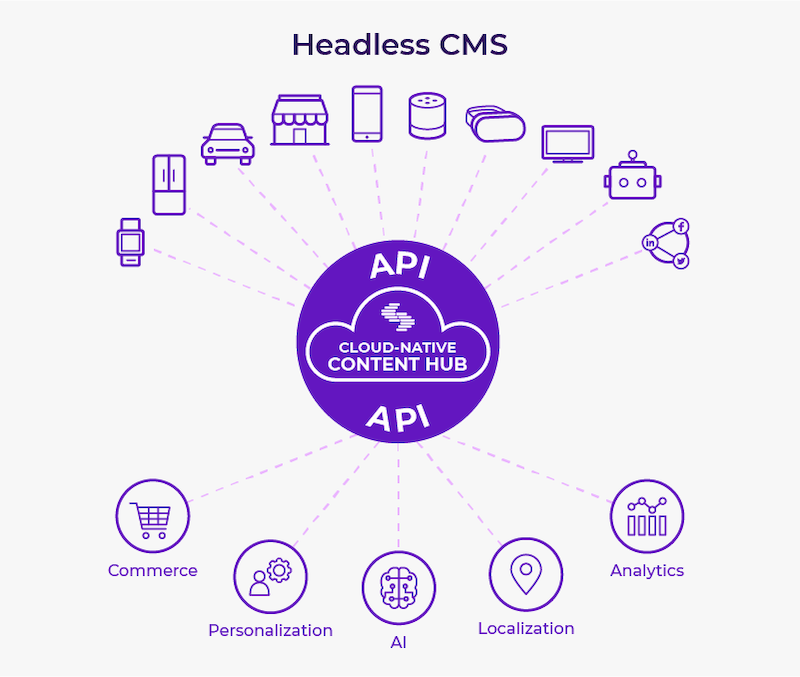If you're a marketer or developer who's been searching for the best of both worlds, then look no further: An agile CMS is the perfect solution for you. An agile CMS gives you all the power of a traditional CMS while also offering the benefits of a headless setup. Whether you need to manage a large website or simply want more flexibility and control over your content, an agile CMS is the perfect choice.
What is a Headless Agile CMS?
A headless agile content management system (CMS) is a decoupled CMS that delivers content through APIs instead of rendering it on the server side. This API-first approach makes headless architecture ideal for agile brands that need to deliver personalized experiences across different consumer touchpoints.

The agile CMS is well suited for digital experiences that are built using modern front-end frameworks such as , and . Headless agile CMSes provide a flexible and scalable approach to delivering content, and they allow developers and marketers to create unique and engaging digital experiences. In addition, headless agile CMSes are often more affordable and easier to maintain than traditional server-side CMSes. As a result, headless agile CMSes are becoming increasingly popular among organizations that are looking to build next-generation digital experiences.
What Are the Benefits of a Headless Agile CMS Over Traditional CMSes?
Agile CMS is a type of content management system that emphasizes speed and flexibility. Unlike traditional CMSes, which can be slow and inflexible, agile CMSes are designed to be quickly updated and easily customized. This makes agile CMSes ideal for businesses that need to frequently update their website content or make changes to their website design. Headless is a core principle of MACH, which is making major waves with its revolutionary approach on a microservices-based, API-first, cloud-native and headless architecture. As a result, agile CMSes offer several benefits over traditional CMSes.
- User-centered content hub
- Built-in planning and real-time collaboration tools
- Ease of use for marketers and developers alike
- Time savings on projects
- Content delivery flexibility
- Integration to existing development stack via API
What Industries Are Best Suited to Agile?
In the world of software development, agile methodology has become widely adopted as the preferred approach for designing and building new applications. Agile CMS is a relatively new approach that combines the benefits of agile methodology with the flexibility of a headless content management system. This makes headless agile CMS well-suited for industries where speed and flexibility are essential, such as media and publishing, e-commerce and marketing.
With a headless agile CMS, developers can quickly and easily make changes to the front end of an application without affecting the back end, and vice versa. This allows for a more agile development process that can respond quickly to changing needs and requirements. In addition, headless agile CMS provides greater flexibility for hosting and deploying applications. This makes it an attractive option for companies that want to avoid the hassle and expense of maintaining their own infrastructure.
Headless Agile CMS Case Studies
Covéa Insurance offers commercial and personal insurance products to customers across the UK. They needed a CMS to consolidate multiple CMSes, integrate with their chatbot, and support the launch of their insurance-as-a-service platform.
What did they achieve?
- Enabled developers to release code within one sprint
- Reduced call center costs through chatbot integration with IBM Watson
- Offered a customizable white-label solution platform for individual clients
Shaw Academy experienced a massive influx of new learners, educators, and course materials due to COVID and desperately needed to upgrade their traditional CMS from the homegrown solution they were using.
What did they achieve?
- 50% faster course publishing time; releasing 90 courses in 9 months
- 5 new languages launched
- Ability to release content 2x per week
A fast-growing startup that was mired in the ticket-based content publishing quagmire of legacy CMSes. They needed a content solution that would empower their teams to scale up personalization, allow marketers and developers to work together efficiently, and lay the foundation for sustainable future growth.
What did they achieve?
- Reusable templates that let marketers directly publish content
- Easy to create and test variations for personalization
- Modular infrastructure that strengthens data security
Are There Any Downsides to Using an Agile CMS?
An agile CMS is a viable option for developers who are looking for a content management system that will allow them to move quickly and efficiently. It is also a good choice for developers who want to take advantage of the latest technology trends. However, there are some potential downsides to using an agile CMS:
- Not as widely adopted as other content management systems
- No built-in user interface
- More expensive up front than traditional CMSes (but more flexible and future-proof)
How Do You Get Started With an Agile CMS?
We have a simple-to-integrate and agile CMS that can help bridge the growing divide between traditional and modern marketing management. Watch our agile CMS demonstration.
- Find out more about agile marketing from
- And learn the ins and outs of an agile CMS for enterprise businesses by reading
See how easy and creative composable commerce can be, at enterprise scale. Using agile headless technology, watch Contentstack build a shop in real time during this webinar series "The ABCs of Composable Commerce."
